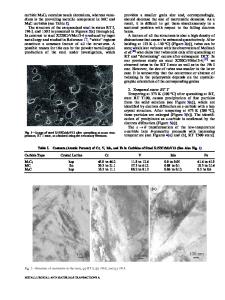Enhanced Mechanical Properties of a Hot-Stamped Advanced High-Strength Steel via Tempering Treatment
- PDF / 1,205,519 Bytes
- 10 Pages / 593.972 x 792 pts Page_size
- 52 Downloads / 413 Views
I.
INTRODUCTION
THE application of ultra-high-strength steels (UHSS) in automotive industries has increased due to the needs for higher passenger safety and weight reduction. Hot stamping is a process to produce UHSS (ultra-high-strength steels) components (mainly made of boron steels) which can be used for A- and B-pillar reinforcements, roof rails, side-wall members, and beams for crash management structures.[1] Different methods have been proposed and applied for hot stamping[2] among which the so-called direct hot stamping is mostly well known. During the direct hot stamping, the blanks are firstly austenitized and then simultaneously formed and quenched in the die. According to Reference 3, the flow stress at a constant strain and strain rate decreases exponentially as the temperature increases. Consequently, not just is the flow stress largely reduced by preheating the sheets, but due to simultaneous occurrence of forming and quenching, forming load and springback decrease and formability increases.[4] Furthermore, the austenitic microstructure transforms into a martensitic one because of the rapid cooling during quenching. The boron-alloyed steels like 22MnB5 have been the desirable choices for the hot stamping applications.[5–7] Minor additions of boron in the order of 0.001 wt pct M. NADERI, Assistant Professor, is with the Department of Mining and Metallurgy, Amirkabir University of Technology, Tehran, Iran. M. ABBASI, Assistant Professor, formerly with Amirkabir University of Technology, Tehran, Iran, is now with Faculty of Engineering, University of Kashan, Kashan, Iran. Contact e-mail: [email protected] A. SAEED-AKBARI, Team Leader, is with the Department of Ferrous Metallurgy, RWTH Aachen University, Aachen, Germany. Manuscript submitted June 18, 2012. Article published online November 30, 2012 1852—VOLUME 44A, APRIL 2013
markedly augment the hardenability, and as a result open the way to develop low temperature transformation products in steels. The decisive mechanism is delay of the bainitic, ferritic, and pearlitic phase transformations after alloying with boron.[8] Naderi et al.[9] analyzed the microstructural and mechanical properties of different B-bearing steels after being hot stamped. The microstructures of the hot-stamped blanks were fully martensitic, and the resultant microstructures provided the yield strength levels of 650 to 1370 MPa and the tensile strength values of 850 to 2000 MPa. Literature surveys suggest two main restrictions in the application of the hot stamping process, namely the surface oxidation[10–12] and the limited toughness[13,14] of the produced specimens. While oxidation is due to the exposure of the sheets to air at elevated temperatures of about 1173.15 K (900 °C), the lower toughness originates from the martensitic microstructure of the hotstamped parts. Liu et al.[15] recently managed to enhance the mechanical properties of the indirectly hot-stamped 22MnB5 steel using the quenching and partitioning (Q&P) process. They successfully generated a duplex microstructure
Data Loading...











